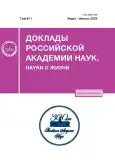METACERCARIAE IN COPROLITES OF SEALS OF THE GENUS PACHYPHOCA (CYSTOPHORINAE, PHOCIDAE) FROM THE LATE MIOCENE OF THE NORTH CAUCASUS
- Authors: Tarasenko K.K.1, Sivkova T.N.2
-
Affiliations:
- Borisiak Paleontological Institute, Russian Academy of Sciences
- Perm State Agro-Technological University named after Academician D.N. Pryanishnikov
- Issue: Vol 511, No 1 (2023)
- Pages: 405-408
- Section: Articles
- URL: https://journals.rcsi.science/2686-7389/article/view/135671
- DOI: https://doi.org/10.31857/S2686738923700324
- EDN: https://elibrary.ru/JMENVL
- ID: 135671
Cite item
Full Text
Abstract
Coprolites of the seal Pachyphoca volkodavi from the Upper Miocene deposits (Kherson) of the Fortepyanka locality (Republic of Adygea) were studied. Two out of five seal coprolites contained a structure resembling fish muscle tissue and included objects with morphology of trematode metacercariae. Obviously, the larvae of the parasite got into the digestive tract of seals from the fish they eat. Microscopic analysis of coprolites did not reveal helminth eggs, which indicates a possible absence of infection.
Keywords
About the authors
K. K. Tarasenko
Borisiak Paleontological Institute, Russian Academy of Sciences
Email: tarasenkokk@gmail.com
Russian Federation, Moscow
T. N. Sivkova
Perm State Agro-Technological University named after Academician D.N. Pryanishnikov
Email: tarasenkokk@gmail.com
Russian Federation, Perm
References
- Тарасенко К.К. Новый вид тюленей рода Pachyphoca (CYSTOPHORINAE, PHOCIDAE) из позднего миоцена Северного Кавказа // Доклады РАН. Науки о Земле. 2022. Т. 507. № 1. С. 75–79.
- Тарасенко К.К., Триколиди Ф.А. Новый представитель рода Cryptophoca (Carnivora, Phocidae, Phocinae, Mammalia) из позднего миоцена Адыгеи // Мат. LXI Сессии палеонтол. о-ва. СПб. ВСЕГЕИ. 2015. С. 175–176.
- Вислобокова И.А., Тарасенко К.К. Находки жвачных (Artiodactyla, Ruminantia) и новые данные по стратиграфии позднемиоценового местонахождения Фортепьянка 2 Северный Кавказ, Республика Адыгея) // Палеонтол. журн. 2019. № 6. С. 105–110.
- Sharma K.M., Patnaik R. Coprolites from the lower miocene Baripada beds of Orissa // Current Science. 2010. V. 99. № 6. P. 804–808.
- Muftah A.M., El Shawaihdi M.H., Alriyadh M., Boaz N.T. Coprolites from the Neogene Sahabi Formation, northeastern Sirt Basin of Libya // Arabian Journal of Geosciences. 2020. V. 13. № 5. P. 1–10.
- Bajdek P., Owocki K., Sennikov A.G., Golubev V.K., et al. Residues from the Upper Permian carnivore coprolites from Vyazniki in Russia – key questions in reconstruction of feeding habits Palaeogeography Palaeoclimatology Palaeoecology. 2017. V. 482. № 2. P. 70–82.
- Scott L., Fernandez-Jalvo Y., Carrion J., and Brink J. Preservation and interpretation of pollen in hyaena coprolites: Taphonomic observations from Spain and southern Africa, Palaeontologia Africana. 2003.V. 39. P. 83–91.
- Jouy-Avantin F., Combes C., Miskovsky J.C., et Mone H. Helminth eggs in animal coprolites from a Middle Pleistocene site in Europe // J. Parasitol. 1999. V. 85. P. 376–379.
- Ferreira L.F., Araujo A., Duarte A.N. Nematode Larvae in Fossilized Animal Coprolites from Lower and Middle Pleistocene Sites, Central Italy // Journal of Parasitology. 1993. V. 79. № 3. P. 440–442.
- Callen E.O., Cameron T.W.M. A prehistoric diet revealed in coprolites // New Scientist 1960. № 8. P. 35–40.
- Клабуков А.С., Сивкова Т.Н. Оптимизация метода паразитологического исследования археологических материалов // Теория и практика борьбы с паразитарными болезнями. 2021. С. 234–239.
- Hunt A.P., Licas S.G. Coprolites of Borophagus (Mammalia:Canidae) from Western North America and the distribution of the coprolites of bone-cracking carnivores in the Late Cenozoic // Lucas S.G., Hunt A.P., and Lichtig A.J. Fossil Record 7. New Mexico. 2021. Museum of Natural History and Science Bulletin 82. P. 151–159.
- Moreno Rodriguez A.P., Chimento N.R., Agnolin F.N., et al. // PALAIOS. 2022. V. 37. P. 402–410.
- Tarasenko K.K., Pakhnevich A.V., Bolshiyanov I.P. Summary of micro CT studies on Late Miocene marine carnivora coprolites from Caucas & Crimea // Micro-CT User Meeting. Mechelen. 2019. P. 110–113.
- Головина Н.А., Стрелков Ю.А., Воронин В.Н., Головин П.П., Евдокимова Е.Б., Юхименко Л.Н. Ихтиопатология / Под ред. Головиной Н.А., Бауера О.Н. М.: Мир, 2003. 448 с.
- Woon-Mok Sohn, Byoung-Kuk Na Infections with Digenetic Trematode Metacercariae in Freshwater Fishes from Two Visiting Sites of Migratory Birds in Gyeongsangnam-do, Republic of Korea // Korean J Parasitol. 2019.V. 57. № 3. P. 273–281.
- Попюк М.Н. Обнаружение метацеркарий Stephanoprora polycestus (TREMATODA: ECHINOSTOMATIDAE) на жабрах атерины Atherina boyeri в Черном море // Паразитология. 2017. Т. 51. № 6. С. 481–489.












